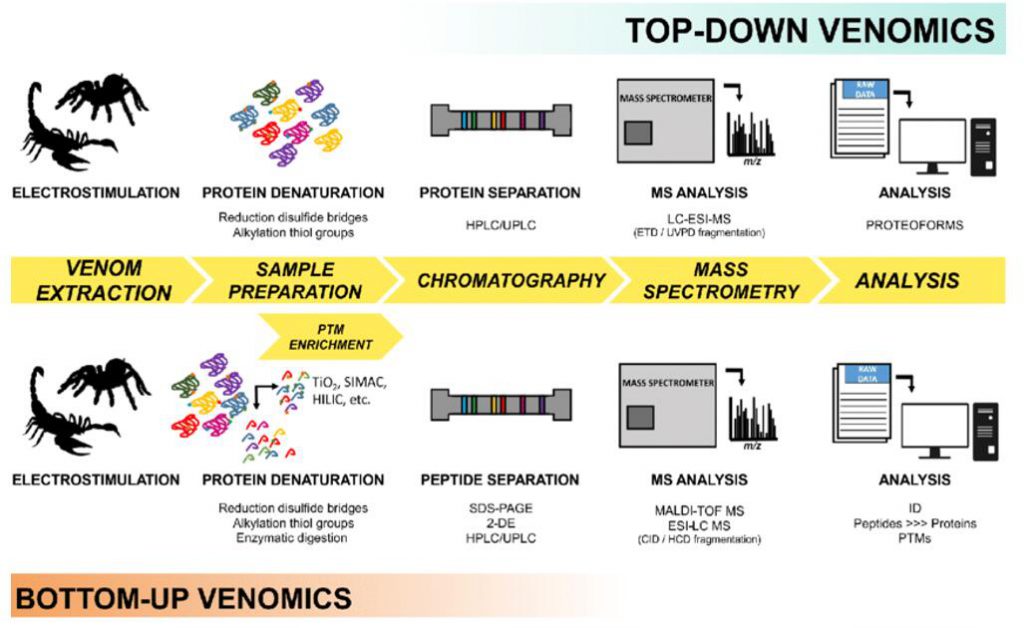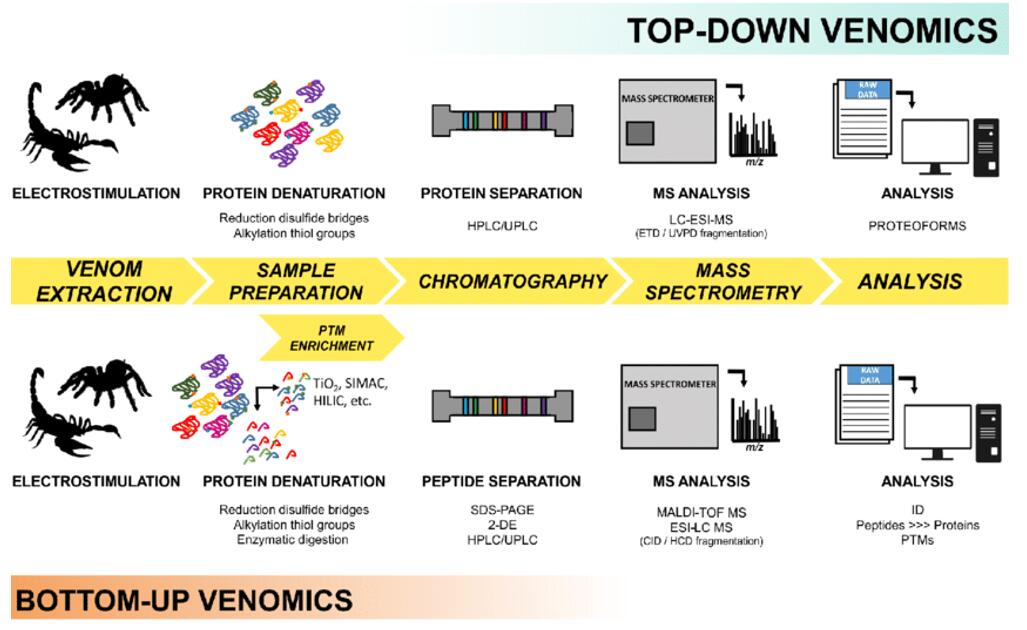What is Venom and Venomics?
Venom is a complex mixture of toxins that is typically injected into another organism through specialized structures such as fangs or stingers. It is produced by certain animals, including snakes, spiders, scorpions, and some marine organisms. Venom serves various functions, such as prey immobilization, self-defense, and competition with other individuals. The composition of venom is diverse, containing proteins, peptides, enzymes, and other bioactive molecules that can have profound effects on the physiology of the envenomed organism.
Venomics is the scientific study of venom and its components, encompassing the identification, characterization, and analysis of the various molecules present in venomous secretions. It involves multidisciplinary approaches, including genomics, proteomics, and metabolomics, to unravel the complex composition and functions of venom. Venomics provides insights into the evolutionary aspects of venomous organisms, their ecological roles, and potential applications in medicine and biotechnology. The goal of venomics is to understand the molecular details of venom and leverage this knowledge for a range of scientific, medical, and ecological purposes.
Components of Venom
Venom is a complex mixture that varies widely across different species of venomous organisms, including snakes, spiders, scorpions, and marine creatures. The composition of venom consists of various bioactive components:
Proteins and Peptides:
- Enzymes: Venom often contains enzymes that target specific biological processes, such as proteases, which break down proteins, and phospholipases, affecting cell membranes.
- Peptide Toxins: Short chains of amino acids with specific targets in the victim's body, affecting nerve cells, blood clotting, or muscle function.
Small Molecules:
- Biogenic Amines: Compounds like histamine that can induce inflammatory responses.
- Metabolites: Small molecules produced during venom synthesis, contributing to the overall toxicity.
Neurotoxins:
- Targeting the nervous system, neurotoxins interfere with nerve cell communication, leading to paralysis or other neurological effects.
Cytotoxins:
- Damaging cell structures, cytotoxins cause cell death and tissue damage.
Metalloproteases:
- Enzymes that affect blood clotting and tissue repair, leading to various effects on the victim's circulatory system.
Understanding the specific combination of these components is essential for deciphering the overall toxicity and potential therapeutic applications of venom.
Biological Functions of Venom
Venom serves various functions crucial for the survival and reproduction of venomous organisms:
Prey Immobilization: Venom aids in capturing and immobilizing prey by disrupting physiological processes or inducing paralysis.
Defense Mechanism: Acting as a potent defense mechanism against predators, venom can deter or incapacitate potential threats.
Competitive Advantage: Intraspecific competition is often mediated by venom, where individuals use venom to establish dominance or secure resources.
Digestion Facilitation: Some venoms contain enzymes that assist in the pre-digestion of prey, making it easier for the predator to extract nutrients.
Predator Deterrence: Bright colors or warning patterns in venomous species signal potential danger to predators, discouraging them from attacking.
Mate Competition: In certain species, venom may play a role in mate competition, influencing reproductive success.
Proteomics in Venom Analysis
Proteomics plays a pivotal role in venom analysis, providing insights into the diverse array of proteins present in venomous secretions. This comprehensive approach involves the identification, characterization, and quantification of venom proteins, unraveling the molecular complexity of venom.
Mass Spectrometry Techniques:
MALDI-TOF (Matrix-Assisted Laser Desorption/Ionization Time-of-Flight): This technique is employed to ionize and analyze proteins, allowing for accurate determination of their mass-to-charge ratio.
LC-MS (Liquid Chromatography-Mass Spectrometry): Coupling liquid chromatography with mass spectrometry enhances the separation and identification of venom proteins, enabling a more detailed analysis.
Database Searching:
Bioinformatics tools are utilized to match mass spectrometry data against existing protein databases, aiding in the identification of venom components.
De novo sequencing techniques are employed to determine the amino acid sequence of proteins not present in existing databases.
Functional Characterization:
Understanding the biological roles of identified proteins is crucial. Proteomic analysis allows researchers to categorize proteins based on their functions, such as enzymes, toxins, or structural proteins.
Venom Protein Modification Analysis:
Proteomics helps identify PTMs, such as glycosylation or phosphorylation, which can significantly influence the activity and function of venom proteins.

Venomic workflow. General workflows for top-down and bottom-up venomics are presented (Marchi et al., 2022).
Metabolomics in Venom Analysis
Metabolomics complements proteomics by focusing on the small molecules produced during the synthesis and breakdown of venomous compounds. This holistic approach provides a comprehensive view of the metabolic pathways involved in venom production.
Techniques such as nuclear magnetic resonance (NMR) spectroscopy and mass spectrometry are employed to identify and quantify metabolites in venom.
Metabolite profiling offers insights into the chemical diversity of venom, encompassing a wide range of small molecules.
Pathway Analysis:
Metabolomics allows researchers to map out the metabolic pathways associated with venom production. Understanding these pathways provides a holistic view of venom synthesis.
Quantitative Metabolomics:
Quantitative analysis of metabolites helps researchers understand the concentration and dynamics of specific compounds in venom over time.
Biosynthetic Pathways:
Metabolomics aids in uncovering the biosynthetic pathways of venom constituents, providing valuable information about the origins and processes involved in venom production.
Correlation with Proteomics:
Integrating metabolomic and proteomic data enables a more comprehensive understanding of the interplay between small molecules and proteins in venom.
Applications of Venomics
The detailed insights provided by venomics, unraveling the composition and functions of venom, have resulted in a myriad of applications across scientific and medical domains. The distinctive bioactive molecules found in venomous secretions have spurred innovative approaches with promising implications for human health, ecological research, and drug development.
Drug Development and Design
- Analgesics and Pain Management:
Venom components, such as peptides targeting ion channels or neurotransmitter receptors, have shown potential as analgesics. These molecules can serve as inspiration for developing novel pain-relief medications.
- Anticoagulants and Cardiovascular Drugs:
Certain venom proteins exhibit anticoagulant properties, which can be explored for the development of cardiovascular medications, especially in preventing blood clot formation.
- Cancer Therapeutics:
Venom peptides have demonstrated selective toxicity against cancer cells. Researchers are investigating these molecules for their potential in developing targeted cancer therapies.
Ecological Research
- Biodiversity Conservation:
Understanding the venom profiles of different species contributes to ecological research by elucidating predator-prey relationships. This knowledge aids in biodiversity conservation efforts.
- Ecosystem Dynamics:
Venomics provides insights into the ecological roles of venomous organisms within ecosystems. This understanding is crucial for preserving the delicate balance of natural environments.
Medical Applications
- Antimicrobial Agents:
Venomous secretions often contain peptides with antimicrobial properties. These molecules are being explored as potential alternatives to traditional antibiotics in the face of growing antibiotic resistance.
- Neurodegenerative Diseases:
Venom components, particularly neurotoxins, offer avenues for research in neurodegenerative diseases. Understanding how these molecules affect the nervous system could lead to insights into conditions like Alzheimer's or Parkinson's disease.
- Autoimmune Disorders:
Venom peptides may hold the key to modulating immune responses. Researchers are exploring their potential in developing therapies for autoimmune disorders.
- Molecular Imaging Agents:
Certain venom proteins, when modified, can act as molecular imaging agents. This has applications in medical diagnostics, allowing for precise visualization of specific cellular processes.
Agricultural and Pest Control
- Insecticides:
Venom components targeting insect physiology can be utilized in the development of environmentally friendly insecticides, reducing reliance on traditional chemical pesticides.
- Crop Protection:
Understanding venomous organisms and their role in pest control can inform agricultural practices, contributing to sustainable and eco-friendly crop protection methods.
Reference
Marchi, Filipi Calbaizer, et al. "Toxinology in the proteomics era: a review on arachnid venom proteomics." Journal of venomous animals and toxins including tropical diseases 28 (2022): 20210034.
